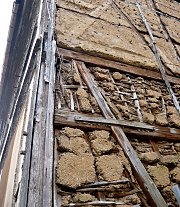Historic Plastered Masonry
This section falls under our plastered masonry umbrella and deals with plastered masonry up to about 1870. Unfortunately, this surface contains all manner of problems, such as coarse gravel in the overlaying plaster and/or in the masonry, unstable natural stone, mixed masonry, wide joints, half-timber and clay, all of which can make securely installing our wire rope systems more difficult. We recommend using the universal drill. Often, abundant use of composite mortar can be a solution (detailed information can be found there).
Mounting: Problems with the Masonry
Beneath the plaster of these old walls you will most likely not find evenly laid brick! The masonry will usually be unevenly stacked with stones that are crumbly and fragile due to age, oft insufficiently load-bearing for rawl-plugging. You can expect to find full blown cavities or during drilling, create your own (as spalling is likely)! Sometimes you will find mixed masonry of different stones, porous bricks, hard clinkers, concrete blocks, etc. the joints of which often have very different widths. The joint mortar itself is ofen very fragile and incapable of load-bearing. Surprises, like-- cavities, old wooden plugs (dowels), plaster and metal inserts, i.e. steel beams over windows, very thick plaster (in recesses or cavities that were compensated by heavy plaster putty)-- can be expected. Case by case solutions are required here, though a go-to remedy is composite mortar, which can be used for filling, levelling, gluing in bolts or their corresponding rawl plugs. Difficulty while drilling is also quite possible. A hammer drill can help instead of a normal impact drill; if you hit any metal, a steel drill bit may be required.
Mounting: Problems with the Plaster
You may encounter the first problems already within the plaster layer. Test the load-bearing strength by gently tapping the surface. It will be necessary to restore the plaster in areas that sound hollow before proceeding with the installation (drilling). Today, the consistent use of sieves (for sifting) ensures a finer and evenly grained sand in the plaster. This was not so in the past, which is why pebbles up to 2 cm in size are sometimes found in ancient plasters! Driling in such areas will invariably cause the plaster to crack and flake. It is helpful to tape over the drill holes with a piece of wide fabric tape or painter's crepe, mark the coordinate cross for the drill hole on it and then drill the hole, carefully removing the tape afterwards. This will prevent pieces of plaster from breaking off. If chipping does occur, the pieces are held by the crepe and then reattached with composite mortar, filler, or similar.
Truss and Timber Frames: Half-Timbering
In buildings built before 1870, wood can sometimes be found when drilling. It may be an old wooden plug (dowel) covered with plaster, or part of a timber frame. In the latter case, the bricks or stones were only used as a 'filler' in the beams themselves and have considerably less load-bearing capacity. It is best to mount anchors directly in the half-timbering rather than in the stone or brick 'compartments.' With 4 'exploratory' drillings (left-right-up-down) to probe the area, you can be sure that you are not at the edge of a beam. For more information on this wall type, go to our section on solid wood.
'Earth' Walls (Mud, Clay, Loam, Adobe, Rammed Earth)
Walls made of rammed earth or mud/adobe bricks can also be problematic, especially behind a thick layer of plaster. With rammed earth, we recommend a particularly deep insertion (about 16 - 24 cm) with composite mortar, with an extra-long shaft and conical drill hole enlarged towards the back ("behind cut" - see below). If you will be mounting into mud/adobe/rammed earth walls, please ask specifically for these special fittings when ordering. With modern clay brick elements, you’ll need to follow the instructions of the manufacturer. Clay infills (fillers) with wooden reinforcement have a very low load-bearing capacity, so mount your trellis in the beams rather than at the level of these infills (‘compartments’).
Suitable Mounts, Plugs, and Drills
All cable trellis systems of FassadenGrün can be used on intact old or historical walls. Use a universal drill for installation. Any problems you encounter (with drilling, etc..) can usually be solved with composite mortar. Instead of mounting with a plastic plug, the anchor screws are then glued directly into the wall. The hole should be conical, enlarging towards the back (by pressing the drill bit in rotation against the walls of the hole). Some special drills allow the hole to be opened 20 to 25 degrees rearwards, which multiplies the holding values by ten! You can refer to our drilling guidelines for further support.

New wooden trellis made of robinia (black locust wood) on an historic parsonage with problematic walls

Grapevines on an old earth (loam) plastered wall

Intact historic masonry with plaster, wire rope trellis in our medium construction style, grapevine

We recommend a universal drill bit like our UB 77777 for drilling into very old masonry.


